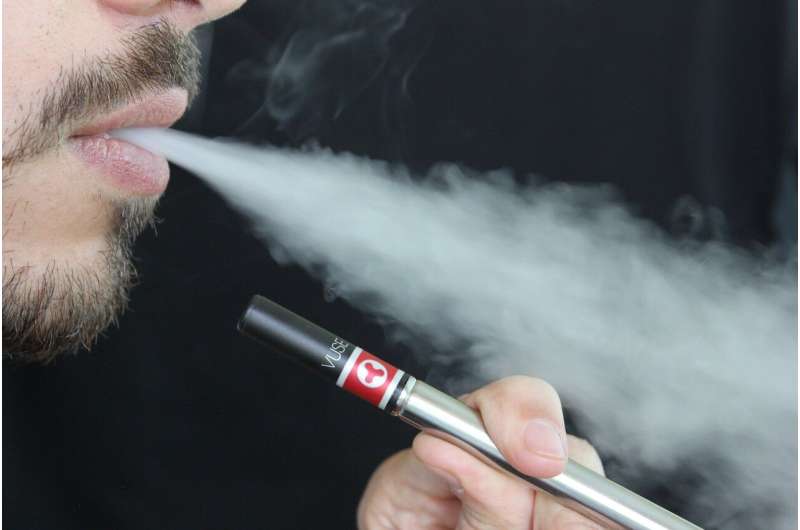This article has been reviewed according to Science X's editorial process and policies. Editors have highlighted the following attributes while ensuring the content's credibility:
fact-checked
peer-reviewed publication
trusted source
proofread
Study shows second-hand vaping exposure very low compared to second-hand smoking

Children exposed to vaping indoors absorb less than one seventh the amount of nicotine as children who are exposed to indoor smoking, but more than those exposed to neither, according to a new study led by UCL researchers.
The study, published in JAMA Network Open looked at blood tests and survey data for 1,777 children aged three to 11 in the United States.
The researchers said that second-hand exposure to harmful substances in e-cigarettes would likely be much lower still, as e-cigarettes deliver similar levels of nicotine to tobacco but contain only a fraction of the toxicants and carcinogens.
The researchers looked at nicotine absorption in children, but they said the findings were likely to be similar for adults.
Lead author Dr. Harry Tattan-Birch, of the UCL Institute of Epidemiology & Health Care, said, "Our study shows, using data from the real world rather than an artificial lab setting, that nicotine absorption is much lower from second-hand vapor than from second-hand smoking.
"Nicotine itself is of limited risk, but it shows what the highest possible exposure might be from second-hand vaping. Exposure to harmful non-nicotine substances present in vapor will likely be substantially lower still."
Senior author Professor Lion Shahab, of the UCL Institute of Epidemiology & Health Care, said, "This paper suggests that concerns about second-hand vaping may be somewhat overstated, with second-hand exposure to toxic substances likely to be very low.
"The findings confirm the risks of smoking indoors around children, which should be avoided at all costs. However, as second-hand vaping still exposes children to more harmful substances than no vaping or smoking exposure at all, it is best to avoid indoor vaping around children, too."
The study used data from a nationally representative sample of children in the US, collected between 2017 and 2020 as part of the annual US National Health and Nutrition Examination Survey (NHANES).
Blood tests that detected the concentration of cotinine were used to assess how much nicotine the children had absorbed. Cotinine is a chemical the body produces after exposure to nicotine. Survey responses indicated if the children had been exposed to smoking or vaping indoors in the past week.
The researchers focused on data from children as, unlike adults, children were unlikely to have vaped or smoked themselves, meaning higher nicotine absorption was a result of second-hand vapor or smoke only. However, two children were excluded from the analysis for having a cotinine concentration that suggested they had vaped or smoked directly. Children exposed to both indoor smoking and vaping were also excluded from the analysis.
The team found that children exposed to indoor vaping absorbed 84% less nicotine than children exposed to indoor smoking, while children exposed to neither absorbed 97% less.
The lower levels of nicotine among those exposed to second-hand vaping were consistent with previous laboratory studies finding that people retained 99% of the nicotine they produced during vaping. With tobacco cigarettes, smoke is generated both by smokers breathing out as well as by the lighted end of the cigarette. E-cigarettes, however, do not generate aerosol aside from when vapers exhale.
The researchers said their findings had implications for whether vaping should be allowed indoors, providing further evidence that the impact of vaping on bystanders' health will be much less than smoking.
However, the researchers said there were other factors to consider when assessing whether indoor spaces should be made vape-free. In particular, if vaping commonly occurs indoors, this may normalize the behavior, encouraging people to start vaping and making it harder for them to stop.
Previous research from the same team showed that adults in England were much more likely to vape than smoke indoors, with 9 in 10 vapers found to vape inside, while only half of smokers smoked inside.
More information: Secondhand Nicotine Absorption From E-Cigarette Vapor vs Tobacco Smoke in Children, JAMA Network Open (2024). DOI: 10.1001/jamanetworkopen.2024.21246



















